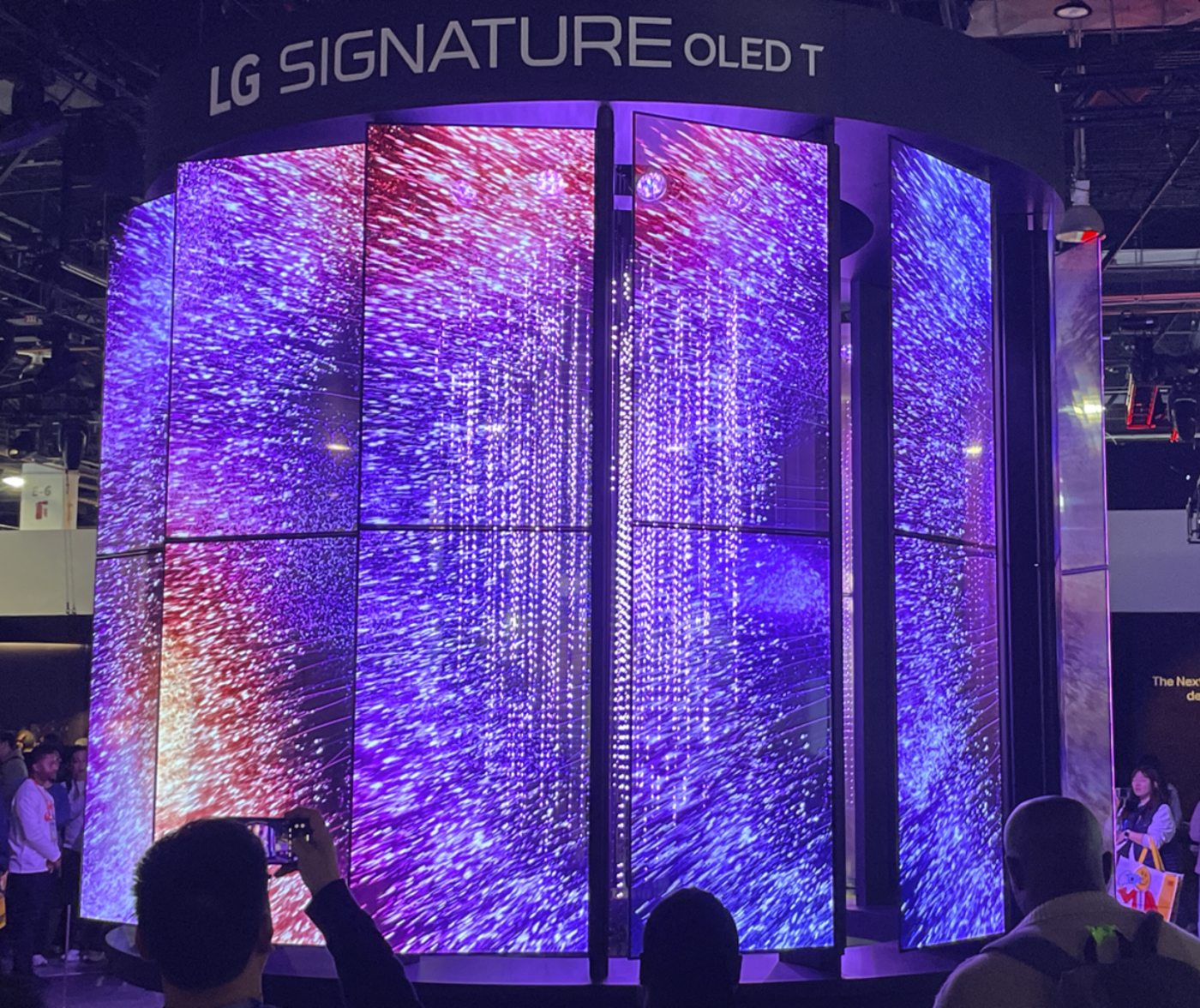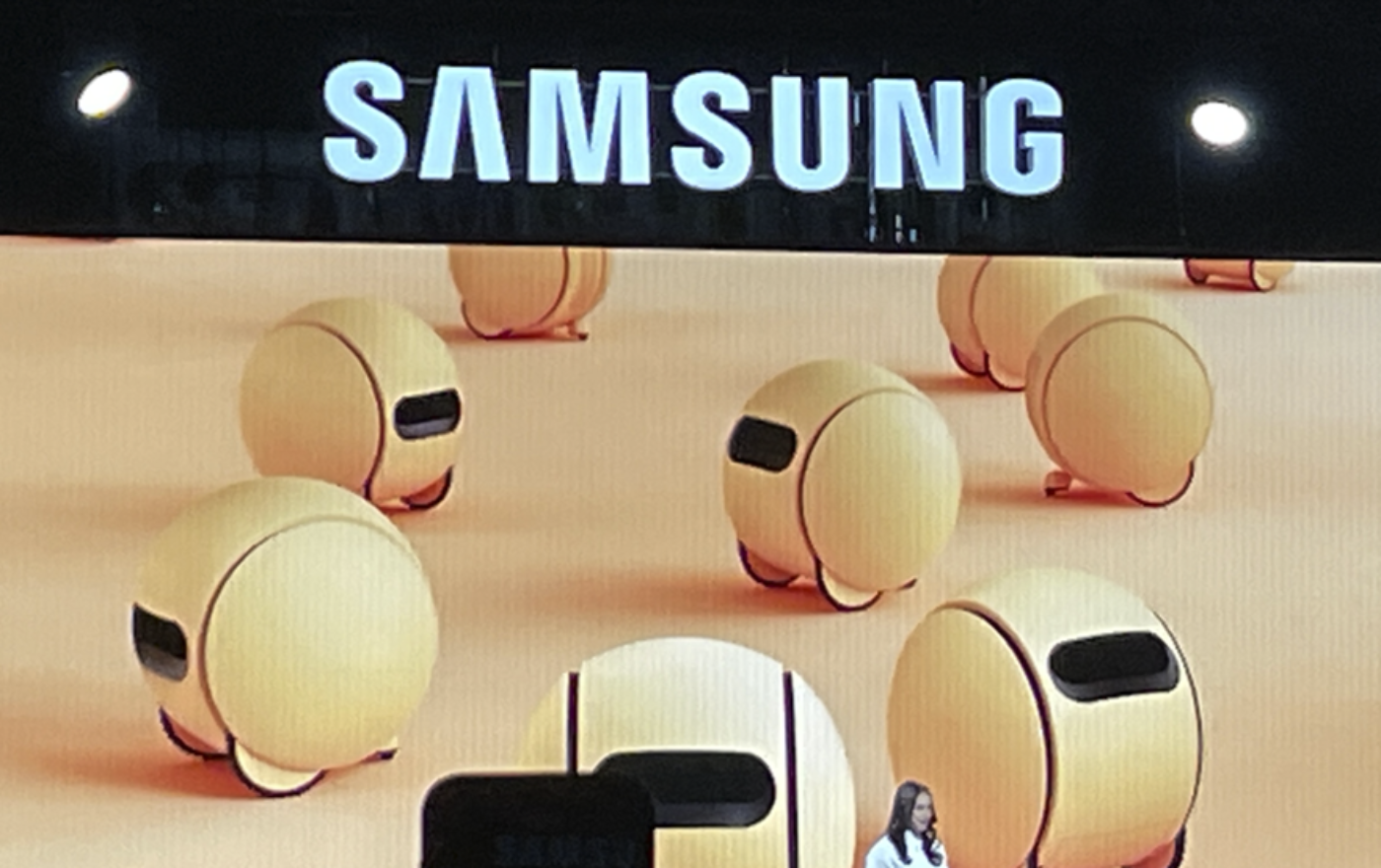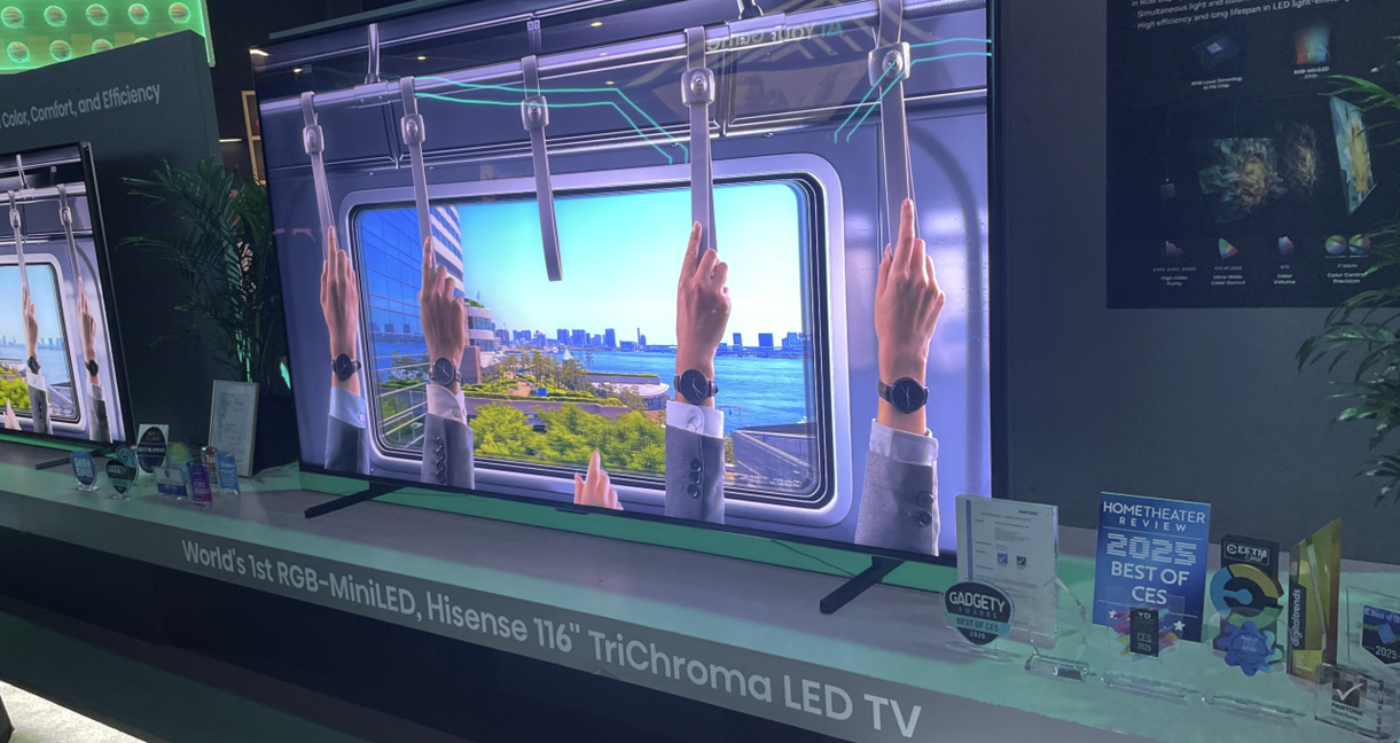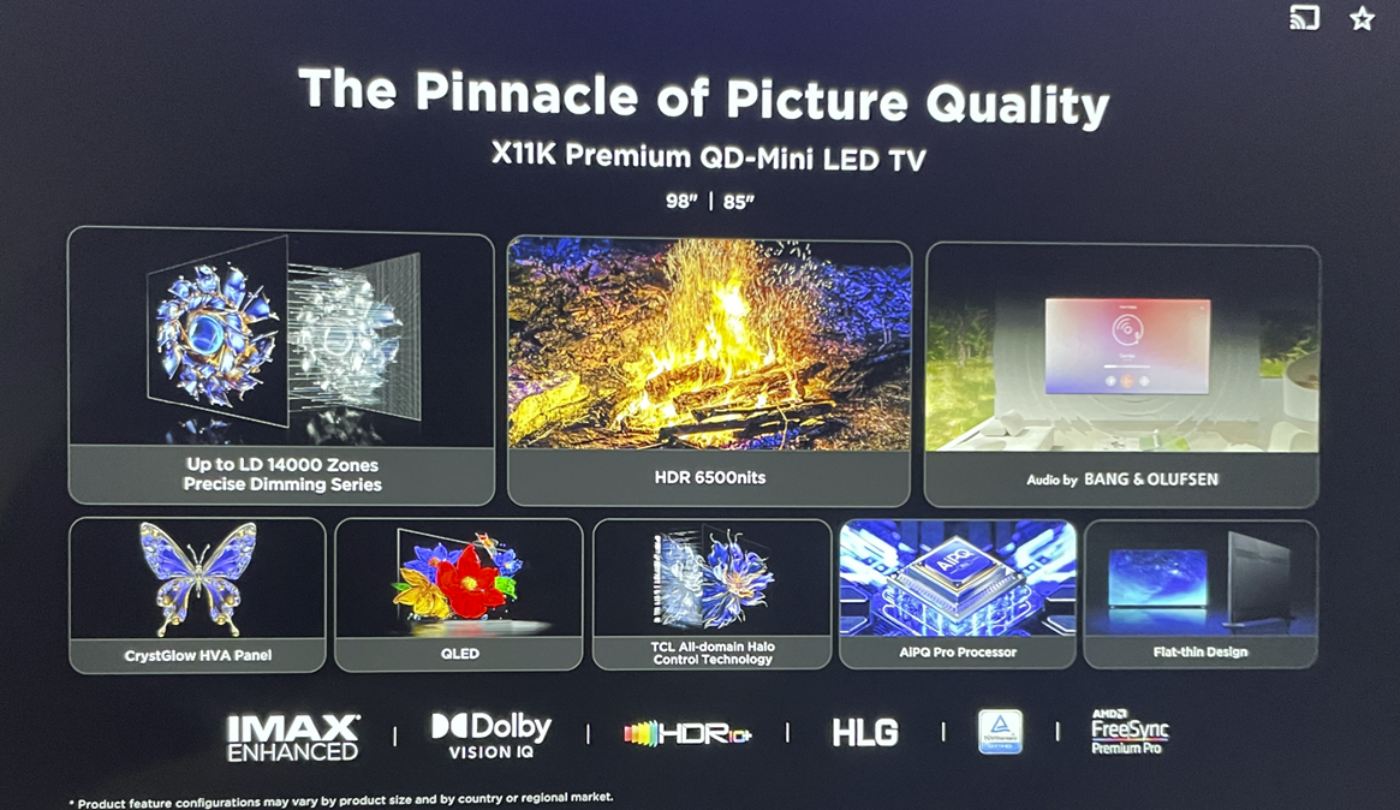CES 2025報告:TVメーカー各社の展示~SamsungとLGはAIに焦点、HisenseとTCLはディスプレイ技術で主導権を主張
これらCounterpoint Research FPD部門 (旧DSCC) 発の分析記事をいち早く無料配信するメールマガジンにぜひご登録ください。ご登録者様ならではの優先特典もご用意しています。【簡単ご登録は こちらから 】
冒頭部和訳
CES 2025の開幕と同時に開催されたメディア向けイベントとメイン展示場では、世界のTVメーカー上位5社がそれぞれ大きく異なる手法で製品を発表していた。韓国の大手2社、SamsungとLGは人工知能 (AI) に焦点を当て、中国の新興競合メーカーであるHisenseとTCLはTV分野におけるディスプレイ技術の主導権を主張した。最後に、Sonyのカンファレンスではコンテンツ事業とのつながりが多く紹介された。ここに挙げたTVメーカーのいずれもが言及していたのは、米国のテック企業との戦略的パートナーシップだった。
TV Makers at CES 2025: Samsung, LG Focus on AI; Hisense, TCL Claim Leadership in Display Tech
In media events held at the start of CES 2025, and in their main exhibit space, the top five global TV makers had very different approaches in their announcements about products. The two South Korean giants, Samsung and LG, focused on artificial intelligence (AI) while the upcoming Chinese competitors, Hisense and TCL, claimed the leadership of display technology in the TV space. Finally, Sony’s conference featured many connections with its content businesses. But all these TV makers described their strategic partnerships with US technology firms.
LG
LG Electronics was the first company to hold its conference on media day. The theme of the company’s presentation was its “Affectionate Intelligence” strategy. LG aims to build a “fundamental trifecta” of devices, AI agents and services. It has partnered with Microsoft on several AI initiatives, including providing cooling centers for Microsoft’s data centers. LG described how AI features can connect its appliances and devices seamlessly to personalize the experience.
LG has used a “day in the life” theme in prior CES shows, and this one emphasized LG’s products in home appliances, automotive components and IT, leaving barely any room for its home entertainment (TV) business.
LG’s exhibit space in the Las Vegas Convention Center (LVCC) Central Hall has surprised attendees every year with a new way to demonstrate the beautiful pictures of OLED in massive structures at the entrance to its exhibit, which is also the first entrance to the Central Hall. This year, it had MicroLED displays in a configuration at the entrance, but as the attendees walked into the exhibit, they saw a big tower of transparent OLED TV displays at the center – LG calls this OLED T.
With respect to the TV product line, the OLED T tower was the beginning and the end of LG’s public exhibit. The exhibit repeated the themes of the media conference focusing on “Affectionate Intelligence”. LG did announce that its flagship OLED TV in 2025 would be capable of 4000 nits of peak brightness. A colleague learned that the company achieved higher brightness with a 4-stack OLED structure without MLA with deuterium used for green and blue.
For the first year in many years, LG Display did not have a large private exhibition, since the company is under severe financial pressure.
Samsung
Like LG, Samsung highlighted its AI initiatives in both its media conference and its exhibits in the LVCC Central Hall. Unlike LG, Samsung put a great emphasis on data security. Samsung has its Knox Matrix platform (Fort Knox is the storage location for the US Federal Reserve’s gold stock) for security working across connected devices, including appliances and laptops as well as TVs. Samsung describes Knox Matrix as a “private blockchain system that provides robust security through multi-layered, intelligent threat monitoring”.
Samsung devices include wearables like watches and rings, and it is working with Dexcom on increased biosensors, which it plans to integrate into Samsung Health. With possibly sensitive health information on the devices, data security becomes even more important.
Samsung has developed a partnership with Intel for laptop AI PCs. The event highlighted its Galaxy Book5 Pro and Galaxy Book 5 360 models. While LG almost completely skipped its TV products, Samsung said its AI-featured TVs will monitor content and adjust picture and sound levels for the viewer and the ambient environment. Samsung will also include generative wallpaper on all its QLED TVs.
Samsung will launch a personal assistant robot named Bolly in 2025. The Samsung conference concluded with a review of B2B solutions, which Samsung characterizes as SmartThings. This will allow personalized experiences at hotels, and additional features for offices, autos and even container ships.
Although I was not surprised that Samsung skipped display technology in its corporate event, I was surprised that it did not discuss its TV streaming service, Samsung TV Plus. Streaming will provide an additional revenue stream through advertisements and is a good fit for AI.
In its exhibit at the LVCC, Samsung completely disregarded its TV business, focusing on AI and consistent with its media conference. Separate from its exhibit, Samsung announced that it would launch a new display technology called RGB MICRO LED, “a technology delivering the first full-color local dimming, lowest power consumption and slimmest design in a consumer display”.
In this case, “MICRO LED” does not have the same meaning that we typically use within Counterpoint Research. We have limited the term MicroLED to direct-view LED displays, but Samsung’s new product has an LED backlight array of Red, Green and Blue LEDs driving an LCD panel, which we would call a MiniLED LCD TV. Samsung did not disclose the size of the LEDs used. Samsung’s new product seems a similar approach to that of Hisense (more on that below).
In Samsung Display’s private exhibit, we saw its latest QD-OLED panel, which it says will be capable of 4000 nits brightness in TVs. Like LG Display, Samsung Display is achieving higher brightness by adding an emitting layer, adopting a five-stack OLED structure with three blue and two green layers to achieve 4000 nits with deuterium used for each color.
Hisense
In the Hisense event, the Chinese TV maker positioned itself as a leading TV brand, taking aim at Samsung as well as its domestic competitor TCL. Hisense has acquired many brands and sells its TVs in different brands; its acquisition of the Toshiba brand has led to success in Japan. Hisense is also actively building its brand in the US and is the official TV brand for the NBA.
As evidence of its leadership, Hisense listed the following statistics:
- Hisense sold 63% of all 100”+ TVs in 2024.
- Hisense is #2 in the “high-end market”.
- Hisense is the fastest growing brand in the US.
- Hisense is the #1 brand in the US for 87” and larger sizes.
- Hisense sales of TVs >$1,000 increased by 4.7x in the latest quarter.
Hisense has been aggressively and successfully promoting its ULED MiniLED LCD TVs, and for 2025 it has a new flagship technology – TriChroma LED TV, which uses red, green and blue LEDs and a local dimming algorithm that employs dimming at each individual color (Hisense calls this RGB Local Dimming Display Technology). The green and blue LEDs are based on GaN while the red LEDs are AlGaInP.
Hisense has developed a special RGB Local Dimming PQ chip to run the algorithm, and claims to achieve substantially better performance than conventional MiniLED TVs with quantum dot films (QD-MiniLED) and Samsung’s QD-OLED displays. Hisense claimed a color gamut of 97% of BT.2020, 16% better than QD-MiniLED and 6% better than QD-OLED, and 87% color volume, 20% better than QD-MiniLED and 3% better than QD-OLED. A major reason for the improved color performance is the narrower green spectrum; Hisense claimed a full-width half maximum (FWHM) of 22nm, compared to 30nm with quantum dots.
The TriChroma LED TV will only be available on Hisense’s new flagship TV, a 116” model that will be capable of peak brightness of 10,000 nits driven by “tens of thousands” of LEDs.
Hisense’s major tie-up in the TV space is with Google, as its smart TVs are based on the Google TV platform and include Gemini AI.
In addition to the TriChroma, Hisense highlighted its laser TVs, with a model capable of 5000 lumens and 110% of BT.2020 (not sure how that works). Finally, Hisense also intends to challenge Samsung in the MicroLED TV category, launching a 136” MicroLED with 4K resolution, 10,000 nits brightness and 95% of BT.2020.
Hisense’s exhibit space followed the same approach as its media conference, with its flagship TV products at the central point of a space larger than in prior years. The Hisense TriChroma LED TV received a plethora of awards, viewable to the left and right of the TV in the picture here.
TCL
Like Hisense, TCL claimed leadership in the TV space, and like Hisense, TCL is trying to build a brand reputation in the US. Where Hisense has the NBA, TCL is the official TV of the NFL, and TCL’s #2 global position is matched by a #2 position in the US. Like Hisense, TCL claimed to be the fastest growing TV brand in the industry. TCL claimed that in 2024 it far outpaced industry growth in TV units, TV revenues, sales of TVs >$1,000, sales of TVs 75” and larger, and TV brand awareness.
TCL claims that its leadership stems from its “totally vertically integrated” corporate structure, with panel maker CSOT under the same TCL umbrella. TCL believes that the TV will be the center of the IoT home system. Against this backdrop, it has partnered with Google (like Hisense) for the TV operating system. The Google TV system includes a Gemini AI-upgraded voice assistant.
TCL’s VP of Product Marketing Scott Ramirez introduced TCL’s MiniLED TVs, and specifically the QM6K series. Ramirez said that TCL has improved its LEDs, achieving a 53% increase in brightness and a 10% increase in efficiency. TCL is also using micro-lenses to allow a reduced optical distance (OD), which improves halo/blooming. He said that this year’s models have improved quantum dot crystals that deliver up to 98% of DCI-P3 color gamut (=70% of BT.2020) for 100,000 hours.
Ramirez boasted that TCL’s MiniLED TVs had 23 bits of backlight control and a dynamic light algorithm that effectively upgraded SDR content to HDR. Ramirez said that good picture performance for a MiniLED was “not just about dimming zones and peak brightness”. He said the QM6K series would be offered at attractive prices for sizes from 50” to 98”.
TCL’s exhibit space at the LVCC led with its MiniLED TV offerings, and while the QM6K series will be available in a wide range of screen sizes, the company’s flagship M11K series will be offered only in 85” and 98”. TCL apparently has chosen not to update last year’s 115” flagship model and still offers the M11G.
As it has done for the past few years, the TCL exhibit in LVCC Central Hall included a small display technology section with “TCL CSOT” labels. The exhibit included tandem stack notebook panels, a 4K 144Hz tablet, a 13.3” tablet with 1100 nits peak brightness, and other technologies.
Finally, TCL said that it will launch a smartphone and a tablet using its NXTPaper technology, which is a transflective LCD. This technology has superior performance under high illumination (such as direct sunlight) but somewhat compromised performance in a dark room.
Sony
Unlike the other companies at CES, Sony chose to hold its media conference at its LVCC booth, preparing a stage and seating there for the purpose. But the Sony media conference was the most entertaining of the day even as it had little new information for display specialists. Sony’s capability to deliver outstanding videos coming from its Sony Pictures business segment far outstrips its consumer electronics rivals.
In 2025, Sony is celebrating 30 years of its PlayStation gaming system, and PlayStation content formed a major part of the conference. The conference had very little to do with consumer electronics, the original purpose of CES (although the Consumer Technology Association, which runs CES, has removed the original full name and just goes by the initials these days). Instead, Sony’s conference addressed activities in its professional products and creative content businesses.
Sony’s COO and CFO Hideki Totoki said that the company’s purpose was to “fill the world with emotion through the power of creativity and technology”. Sony seeks to support creative talent with technology that allows them to realize their vision of storytelling.
In sports, Sony develops technologies to improve broadcasts and increase entertainment. While TCL may be the official TV of the NFL, Sony actually had NFL Commissioner Roger Goodell appear on stage and discuss Sony’s role in improving broadcasts. Sony had 160 video cameras at the most recent Super Bowl, and Goodell highlighted a major NFL initiative to expand the audience for the sport – real-time animated broadcasts. Using tracking software of all the 22 players on the field, in the most recent season the NFL produced a real-time broadcast of a game as if it was played in a Toy Story setting.
A completely separate highlight of Sony’s media conference was its introduction of the Afeela1 car, produced by Sony Honda Mobility. The car was introduced in an automated driving mode, responding to a voice command. This voice-based remote driving was just a demo, but the electric vehicle is now ready for reservation orders, at prices from $89,900 to $102,900 and initially limited to consumers in California.
The rest of the conference addressed activities in its creative businesses – Sony Music and Sony Pictures. There was an extended section on new anime material and upcoming collaboration between Sony’s game designers and its movie production studio.
Panasonic and RCA Returning to US TV Market
Panasonic returned to the US TV market in 2024 but with a limited product line and limited distribution (only Costco and Amazon online). For 2025, Panasonic has expanded its product line to cover 42” to 75” sizes for LCD, including at least one MiniLED model and 55” to 77” OLED.
A brand with an even longer absence from the US market, and which was the dominant TV brand long ago, will return in 2025. The RCA brand has been purchased by a private equity company called established incorporated (all lowercase). established also owns the Thomson brand which has some traction in Europe, and the Vox and Blaupunkt brands. established is working with China-based contract manufacturer Treasure Creek while actively considering alternative supply options to deal with a scenario where Trump tariffs make Chinese imports unviable. RCA has an expanded TV lineup, including OLED TV products.
これらCounterpoint Research FPD部門 (旧DSCC) 発の分析記事をいち早く無料配信するメールマガジンにぜひご登録ください。ご登録者様ならではの優先特典もご用意しています。【簡単ご登録は こちらから 】




